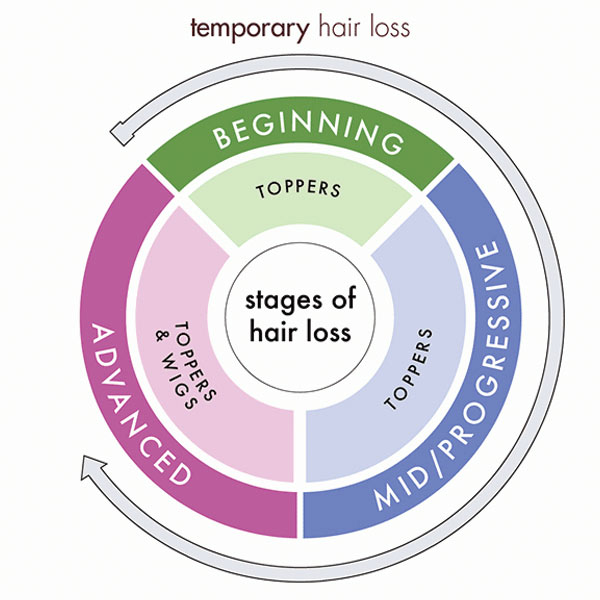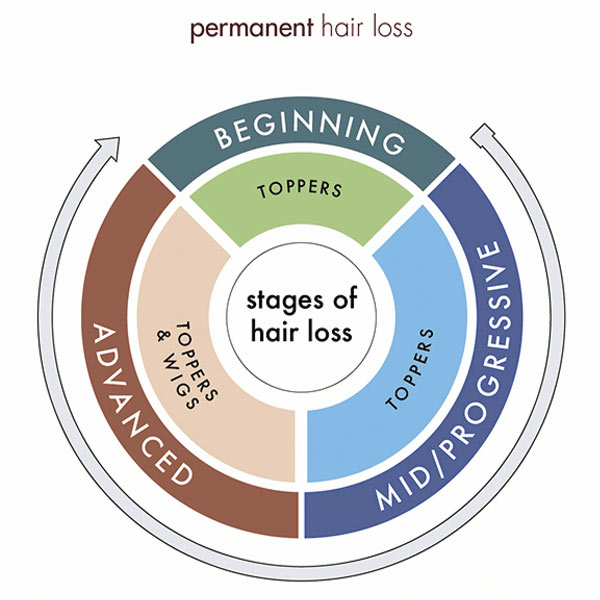Stages of Hairless
Thinning Hair
Many women will, unfortunately, experience some form of hair loss or thinning in their life time, most of us will experience this with age, however others may start to experience this during our younger years. Women may experience various forms of Alopecia or they may experience hair loss or thinning from a medical condition and the treatment for that condition such as chemotherapy or radiation can bring about a temporary or sometimes permanent form of hair loss or thinning.
If there is any reassurance to thinning hair it’s that you are in control of the potential solutions to help you get through this difficult experience. It’s completely your choice as to what options or solutions you chose to apply. These solutions can vary from having your hair stylist give you a shorter haircut to wearing hats, scarves or beanies. Many women have discovered that a topper is an excellent way to provide fullness to thinning hair or to cover up those thinning areas, for others halo’s and hair pieces can help and for those experiencing a greater amount of hair loss, a full wig system may be the best solution.
BEGINNING
Depending on what is causing your hair loss the beginning stages could be signs of receding hair lines or patchy areas of thinning hair. If you are experiencing a medical condition and receiving treatments of chemotherapy and/or radiation then your hair could be falling out in patches or depending on the type of treatments your hair may thin and not completely fall out. Solutions for this stage of hair loss might involve getting a shorter hair cut or procuring a topper or other type of hair piece.
MID/PROGRESSIVE
At this stage of thinning hair, your hair loss is progressing and becoming more noticeable, perhaps resulting in a larger area of thinning or baldness. Solutions at this stage might be best solved using a topper or other type of hair piece.
ADVANCED
In the advanced stage of hair thinning it’s becoming very clear that your bald patches are becoming larger with more area of the scalp visible. At this stage, your only options may be to move to a larger topper or to a full wig system.
Alopecia:
Alopecia can come in many forms and with varying degrees of hair loss. In a given year over 6-million people in the USA can be dealing with some form of Alopecia. Some of the more common forms are as follows:
ALOPECIA AREATA:
Is an autoimmune disease that attacks the hair follicles causing them to slow down their growth. The result is often a patchy thinning area on your scalp. Many people who experience this condition report that their hair grows back and then it may also repeat the hair loss at a later date. Toppers have been used by many people to help them continue leading a normal life without friends and family noticing their hair thinning.
ALOPECIA TOTALIS
This form of Alopecia results in a total hair loss on the scalp. If you are experiencing this type of hair loss you may want to consider a full wig system and pay special attention to the type and quality of the cap construction for your wig. Cap construction plays a key role in a person’s comfort and natural look and feel of the wig.
ALOPECIA UNIVERSALIS
This form of Alopecia results in a total hair loss of the body and scalp. Once again one of the better solutions is a full wig system with a very comfortable cap construction and natural looking hair. Women with Alopecia Totalis or Universalis need to consider the number of hours each day they plan to wear their full wig systems and what types of activities they will be involved in.
Chemotherapy Hair Loss:
There are various types of chemotherapy treatments given out by doctors, not all these treatments will cause or bring about hair loss, however, the majority do. We advise you to call our clinical cosmetologist who can provide you with a free private consultation to help you understand what the potential changes to your hair nails and skin will be based on the type of treatment you will be undergoing.


